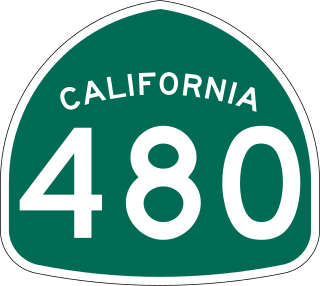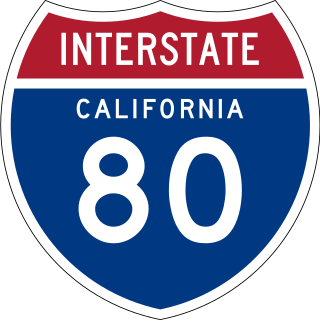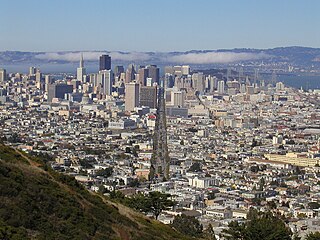This article has multiple issues. Please help improve it or discuss these issues on the talk page . (Learn how and when to remove these template messages)
|
 Looking south along Octavia Boulevard from Fell Street, where the Central Freeway once dominated the landscape. | |
| Namesake | Octavia Gough |
|---|---|
| Location | San Francisco, California |
| South end | |
| North end | Fell Street in Hayes Valley |

Octavia Boulevard (designated as Octavia Street north of Hayes Street) is a major street in San Francisco, California, that replaced the Hayes Valley portion of the damaged two-level Central Freeway. [1] Once a portion of Octavia Street alongside shadowy, fenced-off land beneath the elevated U.S. Route 101 roadway, Octavia Boulevard was redeveloped and redesigned upon the recommendation of a "Central Freeway" planning committee representing a broad array of neighborhoods, including the surrounding Hayes Valley and Western Addition, the Richmond District, Pacific Heights and the Sunset District with representatives appointed by Mayor Willie Brown and the Board of Supervisors and led by the Planning Department of San Francisco. Elements of the San Francisco General Plan were consulted for issues such as urban design, transportation mobility and congestion management, community safety and historic preservation, along with the evaluation of the impacts following the recent removal (1991) of the elevated Embarcadero Freeway and the revitalization of the Embarcadero as a surface boulevard complemented by an extension of the Muni Metro light-rail transit subway.
Contents
The committee was charged to come up with alternatives to rebuilding the damaged double-decked freeway in a six-month public planning process. During this time, the planning services of Allan Jacobs, the former Planning Director and Chair of the UC Berkeley College of Environmental Design and his business partner and UC Berkeley Landscape Architecture professor Elizabeth MacDonald, whose academic studies of landscaped, multi-lane surface roadways were being compiled for publication as "The Boulevard Book" (2002), were engaged. This lead to a proposal for rebuilding Octavia Boulevard without the freeway structure, which was concurrently reviewed and ultimately deemed "acceptable" in traffic carrying capacity as an alternative to a freeway ramp by Caltrans, which informed the endorsements of the civic design think-tank SPUR, both the Planning and the Parking and Traffic Commissions, and Mayor Willie Brown in his "State of the City" address in October 1997. Opponents to the demolition of the freeway structure north of Market Street, mostly based in the Richmond and Sunset Districts in the western half of San Francisco, responded by circulating petitions to place a ballot initiative (Proposition H) before voters calling to rebuild the freeway rather than to demolish it.
The ballot measure, which did not include references to the progress and design of the replacement surface boulevard, was passed by the voters in November 1997. Members of the Central Freeway planning committee, led by community activists Robin Levitt and Patricia Walkup, regrouped immediately to draft another ballot initiative (Proposition E) calling for the surface boulevard as the preferred alternative to rebuilding the elevated structure north of Market, supported by the urban design benefits of the boulevard and its acceptability per Caltrans' standards in carrying traffic. Proposition E was approved by the San Francisco voters in November 1998, setting the stage for a first and final side-by-side ballot showdown before the voters in November 1999: the pro-boulevard Proposition I against the pro-freeway initiative Proposition J. Proposition I won (54% to 46%) and Proposition J (47% to 53%) failed, and demolition of the elevated portions of the freeway north of Market was completed in 2003.
Octavia Boulevard is four blocks long from Market to Fell Street, containing multiple lanes that separate local and through traffic. On Octavia, homes and businesses located immediately on the street are served by the quieter outer roadways, while lanes leading to and from the rebuilt Central Freeway spur connect faster traffic with the inner roadways. Having replaced a freeway, the boulevard distributes traffic smoothly and evenly throughout the immediate neighborhood, while maintaining the links to the major San Francisco traffic arterials that the old elevated freeway used to connect to directly, including Fell and Oak Streets (which serve the city's western neighborhoods) and Franklin and Gough Streets (which serve northern neighborhoods and the Golden Gate Bridge). A brand new park named "Patricia's Green" (named in honor of Patricia Walkup, who died in 2006) was created as part of the boulevard project. It lies on Octavia between Fell and Hayes Street.
North of Hayes Street, Octavia continues as Octavia Street through the Western Addition, Pacific Heights and Marina neighborhoods to Bay Street, at Fort Mason.
Other freeway removal projects in the San Francisco Bay, due to seismic stability (or collapse), include the replacement of San Francisco's Embarcadero Freeway, and the reuse of the collapsed Cypress Structure's right-of-way in neighboring Oakland.
















